This past week has shown some volatility, especially with Monday’s pullback, but all model portfolios gained with the exception of the income portfolio, which dropped slightly.
Again, there is no right or wrong, or better or worse, when it comes to portfolios; the only thing that matters is what’s appropriate for your particular circumstances.
Let’s take a look at the first one:
1. ETF Trend Tracking Model Portfolio
This is the portfolio allocation I predominantly use in my advisor practice. Given current market conditions, and an ever growing number of global hotspots, I like the concept of having a solid core holding in PRPFX.
Around this fund, I have added what I call boost components consisting of ETFs that can produce higher returns than my core holding, at least during bullish periods. When a market pullback occurs, the core holding will add an element of stability.
This is exactly what happened early in March, when the double natural disasters struck Japan. While the S&P 500 lost all of its YTD gains, and dropped into negative territory, this portfolio stayed positive.
Nevertheless, as you know from my writings, anything I invest in involves the use of trailing sell stops, which are shown and tracked on the upper right of the table.
2. Conservative ETF Growth Portfolio
This portfolio, as are the following ones, would be typical of what is being used in the buy-and-hold community, as you can see by the 40% allocation to various bond ETFs. If you are conservative, this simple combination could work for you, but I still recommend the use of the trailing sell stops during these uncertain times.
3. Aggressive ETF Growth Portfolio
What makes this one aggressive is the 15% allocation to bonds. This portfolio is leading the bunch on a YTD basis, because we are in a bullish period. When a correcion occurs, this one will lose value faster than all of the others.
However, if you have an aggressive streak in your personality, you could consider this one. If you use my recommended sell stop discipline, you know exactly ahead of time what your risk will be.
4. Moderate ETF Growth Portfolio
I call this one moderate growth, because of the higher allocation to various bond ETFs (26%) than in the aggressive set up above. It is also more diversfied domestically, but as the YTD return shows, that does not seem to matter much as it slightly trails my Trend Tracking Portfolio.
5. ETF Income Portfolio
This is as simple as it gets, but in the current market environement, this portfolio ranks #2, just behind the aggressive version. Howver, when a market set back occurs, this one could drop in value quickly due to no offsetting bond positions. Be sure to use a 7% sell stop on all holdings.
The key to selecting a portfolio from the above list is not just performance. Personally, I’d rather lag a little on the upside but have some assurance that I will also lag when the downside comes into play.
This will help to sidestep whipsaw signals on occasion, which are caused by temporary market pullbacks followed by a subsequent resumption of the previous up trend.
I will update these portfolios every Wednesday and inform you via email that the updated versions have been posted.
Quick Reference:
4/13/2011 Model Portfolio Post: https://theetfbully.com/2011/04/5-etf-model-portfolios-you-can-use/
Contact Ulli
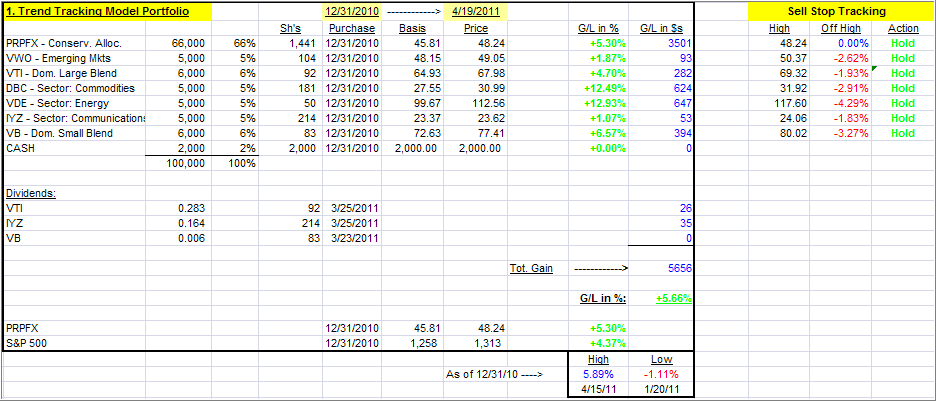
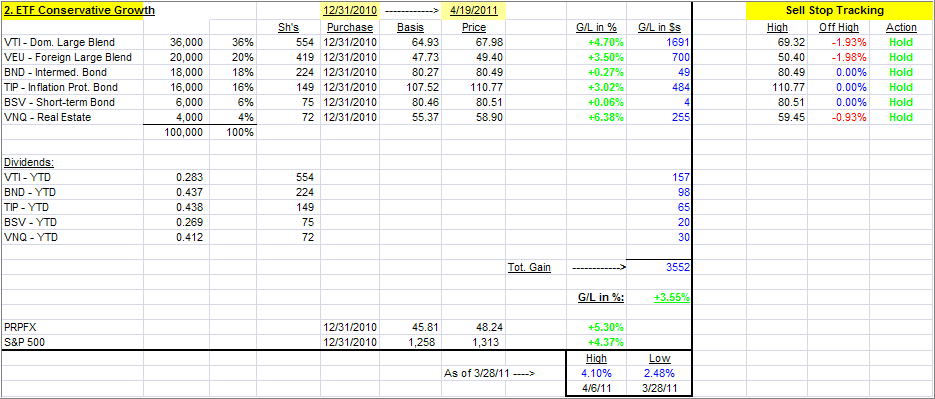
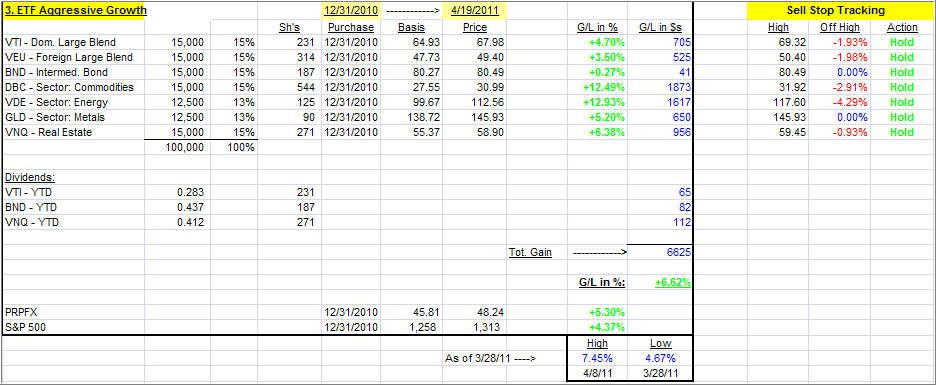
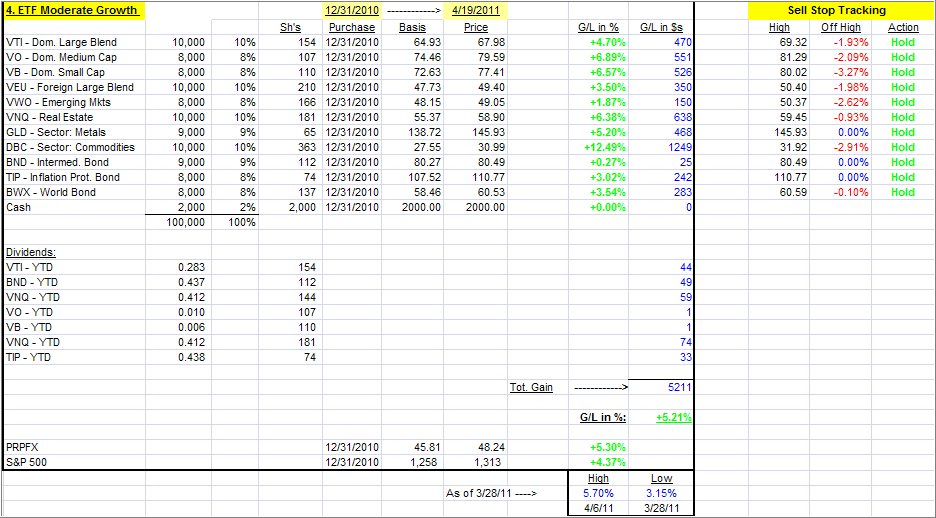
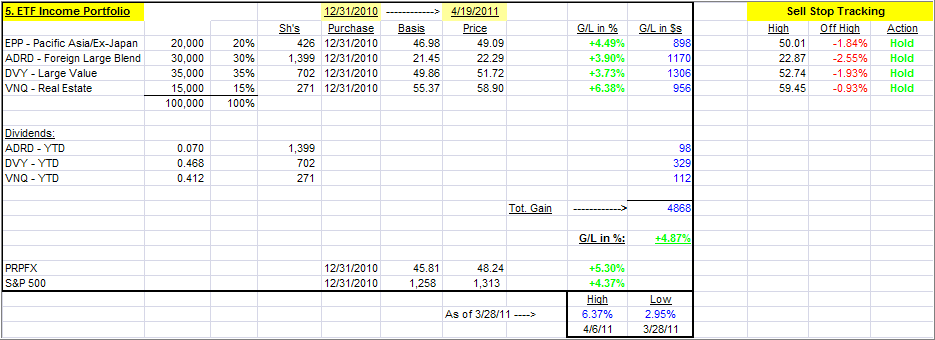
Comments 6
Hi Ulli,
Thanks for starting up this blog. It looks like it will be very helpful. Do you use data feeds to auto-populate these spreadsheets? (I’m assuming you use Excel.) Or do you manually update the information? In particular, the sell stop data seems difficult to get. Where do you get the “high” and “off high” figures from?
Do you have downloadable Excel templates that would make setting one of these up easier?
Thanks for any advice. I appreciate your willingness to share your knowledge!
~ Lori M.
Lori,
I download the data from an external source into Excel. The sell stop points have to be updated manually whenever each position makes a new high, which is identified by the 0.00% number in the “Off High” column.
Ulli…
Hi Ulli – Do you use the Tracking Portfolio to generate your trend tracking charts and sell signals? Or do you use this as your primary investment portfolio?
This information is most helpful. Thank you for sharing your wisdom with us.
Weems
Wheems,
No the charts have nothing to do with the portfolios. I just wanted to show a small sample of portfolio options including the one I primarily use in the current market environment.
Ulli…
Ulli,
Its a great feature, hope you will continue to update it on a regular basis ( weekly/Monthly ?? ).
Regards
Updates are posted every week….
Ulli…